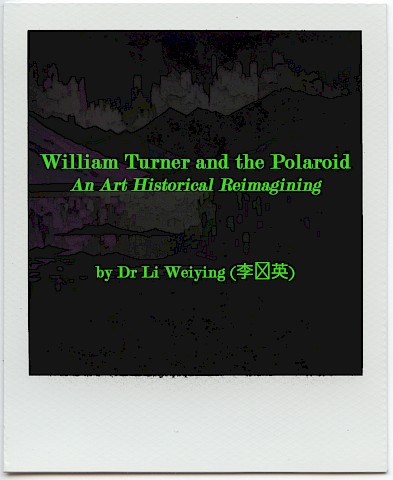|
2025 |
000 - William Turner and the Polaroid
| |

| ||
|
William Turner and the Polaroid: An Art Historical Reimagining The works of J.M.W. Turner (1775–1851), the great British Romantic painter, have long been celebrated for their revolutionary approach to light, atmosphere, and the sublime. Turner’s ability to capture the ephemeral qualities of nature—whether the fiery glow of a sunset, the tempestuous fury of a storm, or the delicate haze of a distant horizon—has cemented his legacy as a precursor to modern abstraction. Yet, what if Turner had access to the immediacy and intimacy of Polaroid photography? This speculative question lies at the heart of an innovative series of works that reimagine Turner’s œuvre through the lens of a 20th-century medium, blending historical artistry with contemporary technological imagination. The Polaroid, invented in the mid-20th century, revolutionised photography by offering instant, tangible images. Its distinctive square format, saturated colours, and occasional imperfections created a unique aesthetic that bridged the gap between documentation and artistry. By transposing Turner’s visionary landscapes and seascapes into the realm of Polaroid photography, this series invites viewers to consider how Turner’s preoccupation with light and transience might have manifested in a different technological era. The result is a fascinating dialogue between the Romantic sensibility of the 19th century and the instantaneity of the 20th. Turner’s paintings often evoke a sense of the fleeting moment—a ship vanishing into a misty horizon, the sun dissolving into a turbulent sky. These themes resonate deeply with the Polaroid’s inherent qualities: its ability to capture a singular, unrepeatable instant, its vulnerability to light and time, and its tactile presence as an object. In this series, Turner’s ethereal compositions are reimagined as Polaroid snapshots, as though the artist himself had wandered through his landscapes with a camera in hand. The soft edges and dreamlike quality of his paintings translate surprisingly well to the Polaroid’s idiosyncratic aesthetic, creating a sense of intimacy and immediacy that feels both anachronistic and timeless. The use of a Machine Learning Model to generate these new works adds another layer of complexity to the project. By training the model on Turner’s existing oeuvre, the algorithm extrapolates his style into new compositions, which are then rendered as Polaroids. This process raises intriguing questions about authorship, creativity, and the role of technology in art. Is the machine a collaborator, a tool, or a medium in its own right? The resulting images, while unmistakably Turnerian in spirit, also bear the subtle imprint of the algorithm’s interpretation, creating a hybrid form that blurs the boundaries between past and present, human and machine. In the context of an exhibition, these fictive Polaroids offer a fresh perspective on Turner’s legacy. They challenge us to reconsider his work not as static artefacts of the past, but as dynamic, evolving expressions that can resonate across time and medium. The Polaroid format, with its associations of nostalgia and immediacy, invites viewers to engage with Turner’s vision in a more personal and tactile way. Each image becomes a relic of a moment that never was, a fragment of a parallel artistic history. Ultimately, this series is not merely an exercise in technological novelty, but a profound meditation on the nature of art and time. It asks us to imagine how Turner, a painter so deeply attuned to the transient beauty of the world, might have responded to the Polaroid’s promise of capturing the fleeting instant. In doing so, it bridges the gap between the Romantic era and our own, reminding us that the pursuit of light, atmosphere, and emotion is a timeless endeavour—one that transcends the boundaries of medium and era. This series of works invites viewers to step into a speculative realm where Turner’s genius meets the Polaroid’s immediacy, and where the past is reimagined through the lens of the present. It is a celebration of artistic innovation, a testament to the enduring power of Turner’s vision, and a provocative exploration of the ways in which technology can expand our understanding of art history. Dr. Li Weiying (李伟英) , cm x cm. Property of the artist. | ||
|
Shown at: | ||